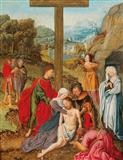Early Netherlandish School, 16th Century
The Lamentation of Christ,
oil on panel, 57 x 44 cm, framed
Provenance:
Schloss Bärenklau, Guben, Germany;
Staatliche Schlösser und Gärten Potsdam-Sanssouci (inv. No. GK 50449), 1951–2005;
restituted to the heirs of the owner, 2005;
Private collection, Germany
In the present painting the bright, light colours and elaborately folded fabrics, as well as the characteristic heads, mark this as a work from the immediate circle of Geertgen tot Sin Jans of Haarlem (circa 1465 – circa 1495). An attribution to Jacob Cornelisz. van Oostsanen (before 1470 – before 1533) appears plausible. Oostsanen was presumably born in the small parish of Oostzaan between Amsterdam and Zaanden in the Northern Netherlands. His name was included in the records of the Amsterdam guild of Saint Luke in 1505, and 100 years later in Karel van Mander’s Het Schilder-Boeck of 1604. His style is largely influenced by traditional Netherlandish painting, and he is often considered the last representative of this era, as his works display little of the Italian Renaissance influence which was pervading Dutch art at the time. Jacob Cornelisz. van Oostsanen was among the followers of Geertgen tot Sin Jans of Haarlem, the most influential Dutch master of the fifteenth century, and could have been one of his pupils. His works also display the influence of Lucas van Leyden. Typical for this artist is his interest in fabrics, which he often depicted elaborately draped and spread out within his works
View it on
Sale price
Estimate
Time, Location
Auction House
The Lamentation of Christ,
oil on panel, 57 x 44 cm, framed
Provenance:
Schloss Bärenklau, Guben, Germany;
Staatliche Schlösser und Gärten Potsdam-Sanssouci (inv. No. GK 50449), 1951–2005;
restituted to the heirs of the owner, 2005;
Private collection, Germany
In the present painting the bright, light colours and elaborately folded fabrics, as well as the characteristic heads, mark this as a work from the immediate circle of Geertgen tot Sin Jans of Haarlem (circa 1465 – circa 1495). An attribution to Jacob Cornelisz. van Oostsanen (before 1470 – before 1533) appears plausible. Oostsanen was presumably born in the small parish of Oostzaan between Amsterdam and Zaanden in the Northern Netherlands. His name was included in the records of the Amsterdam guild of Saint Luke in 1505, and 100 years later in Karel van Mander’s Het Schilder-Boeck of 1604. His style is largely influenced by traditional Netherlandish painting, and he is often considered the last representative of this era, as his works display little of the Italian Renaissance influence which was pervading Dutch art at the time. Jacob Cornelisz. van Oostsanen was among the followers of Geertgen tot Sin Jans of Haarlem, the most influential Dutch master of the fifteenth century, and could have been one of his pupils. His works also display the influence of Lucas van Leyden. Typical for this artist is his interest in fabrics, which he often depicted elaborately draped and spread out within his works



